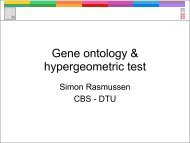Computational tools and Interoperability in Comparative ... - CBS
Computational tools and Interoperability in Comparative ... - CBS
Computational tools and Interoperability in Comparative ... - CBS
Create successful ePaper yourself
Turn your PDF publications into a flip-book with our unique Google optimized e-Paper software.
Microb Ecol<br />
DOI 10.1007/s00248-009-9596-7<br />
MINIREVIEWS<br />
On the Orig<strong>in</strong>s of a Vibrio Species<br />
Tammi Vesth & Trudy M. Wassenaar & Peter F. Hall<strong>in</strong> &<br />
Lars Snipen & Kar<strong>in</strong> Lagesen & David W. Ussery<br />
Received: 3 July 2009 /Accepted: 17 September 2009<br />
# The Author(s) 2009. This article is published with open access at Spr<strong>in</strong>gerl<strong>in</strong>k.com<br />
Abstract Thirty-two genome sequences of various Vibrionaceae<br />
members are compared, with emphasis on what<br />
makes V. cholerae unique. As few as 1,000 gene families<br />
are conserved across all the Vibrionaceae genomes analysed;<br />
this fraction roughly doubles for gene families<br />
conserved with<strong>in</strong> the species V. cholerae. Of these,<br />
approximately 200 gene families that cluster on various<br />
locations of the genome are not found <strong>in</strong> other sequenced<br />
Vibrionaceae; these are possibly unique to the V. cholerae<br />
species. By compar<strong>in</strong>g gene family content of the analysed<br />
genomes, the relatedness to a particular species is identified<br />
for two unspeciated genomes. Conversely, two genomes<br />
T. Vesth : T. M. Wassenaar : P. F. Hall<strong>in</strong> : L. Snipen :<br />
K. Lagesen : D. W. Ussery (*)<br />
Center for Biological Sequence Analysis,<br />
Department of Systems Biology,<br />
The Technical University of Denmark,<br />
Build<strong>in</strong>g 208,<br />
2800 Kgs. Lyngby, Denmark<br />
e-mail: dave@cbs.dtu.dk<br />
T. M. Wassenaar<br />
Molecular Microbiology <strong>and</strong> Genomics Consultants,<br />
Zotzenheim, Germany<br />
P. F. Hall<strong>in</strong><br />
Novozymes A/S,<br />
Krogshøjvej 36,<br />
2880 Bagsværd, Denmark<br />
L. Snipen<br />
Biostatistics, Department of Chemistry, Biotechnology,<br />
<strong>and</strong> Food Sciences, Norwegian University of Life Sciences,<br />
Ås, Norway<br />
K. Lagesen<br />
Centre for Molecular Biology <strong>and</strong> Neuroscience <strong>and</strong> Institute<br />
of Medical Microbiology, University of Oslo,<br />
Oslo, Norway<br />
presumably belong<strong>in</strong>g to the same species have suspiciously<br />
dissimilar gene family content. We are able to identify a<br />
number of genes that are conserved <strong>in</strong>, <strong>and</strong> unique to, V.<br />
cholerae. Some of these genes may be crucial to the niche<br />
adaptation of this species.<br />
Introduction<br />
The species concept for bacteria has long been under siege<br />
from several angles, <strong>and</strong> now with thous<strong>and</strong>s of bacterial<br />
genomes be<strong>in</strong>g sequenced, the disputes have <strong>in</strong>tensified [8].<br />
One frequently used def<strong>in</strong>ition of a bacterial species is “a<br />
category that circumscribes a (preferably) genomically<br />
coherent group of <strong>in</strong>dividual isolates/stra<strong>in</strong>s shar<strong>in</strong>g a high<br />
degree of similarity <strong>in</strong> (many) <strong>in</strong>dependent features,<br />
comparatively tested under highly st<strong>and</strong>ardized conditions”<br />
[12]. Such <strong>in</strong>dependent features are usually phenotypes that<br />
can easily be tested. For a new species to be def<strong>in</strong>ed,<br />
amongst other criteria, <strong>in</strong>ter-species DNA–DNA hybridisation<br />
has to be below 70%, although this rule is not<br />
without its limitations [18]. In the late 1970s <strong>and</strong> 1980s, the<br />
16S rRNA gene sequence was <strong>in</strong>troduced as a molecular<br />
clock that could be used to <strong>in</strong>fer phylogenetic relationships<br />
[50]. Ideally, isolates belong<strong>in</strong>g to the same species have<br />
identical or nearly identical 16S rRNA genes, <strong>and</strong> these<br />
differ from isolates belong<strong>in</strong>g to different species [32, 44].<br />
In practice, this is not always the case. Examples exist of<br />
different species shar<strong>in</strong>g identical rRNA genes (for<br />
<strong>in</strong>stance, E. coli <strong>and</strong> Shigella [37] that are even placed <strong>in</strong><br />
different genera); <strong>in</strong> addition, isolates of one species can<br />
have different rRNA genes beyond the 97% that is<br />
considered to demarcate species [4]. Lateral transfer of<br />
genetic material (to which ribosomal genes are believed to<br />
be resistant) destroys the phylogenetic relationship, so that









